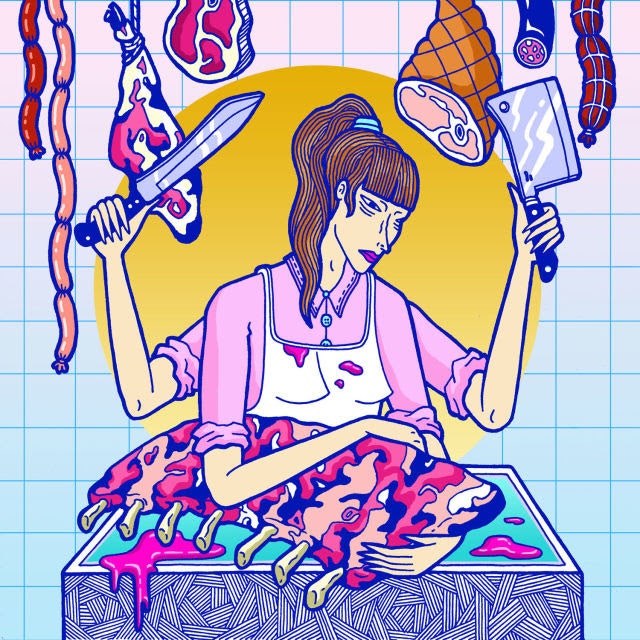Somebody, one of the men, heaved it onto the block, and it made a thud that shook the wood. Smaller than I expected it to be, still with the stiffness of death, a rose-hue meat peeped softly through white fat covering the entire carcass. They watched me for a little while, five men, all over 40, waiting for a reaction. When they didn’t get one, they went back to their work. I had imagined, after spending days heaving soft parts and thick bones around the cold room, that a whole carcass would make a difference. It was just over a meter long. My brain did nothing to dissociate this with a living thing. I thought of Easter and of daffodils and tiny wool-covered lambs bleating softly and then of the rigid body in front of me.
One of the butchers took a hand saw and removed the breast bones, pushed his knife into the soft cartilage of the vertebrae, and separated it in front of me. He handed his wet, greasy knife to me, and brought out another.
I looked inside of its body; thin white ribs encased an empty space where organs would have been. He told me to count four ribs and make a cut, told me that sawing bone was like sawing wood, but I was sixteen and I’d never sawed anything. Start slowly, he said. I staggered through the cartilage and made a mess, snapping the breast beneath my heavy hand. Inside, the meat was a deep pink, silver seams and clumps of creamy fat. He showed me how to take the bone from a leg, pushed the blade through a knuckle joint and separated it with a crack, peeled away thick layers of meat from the femur. He was quick, and heavy-handed, tossed the parts around and rolled them across the wood to the man on the next block.
They operated like machines: knife in, twisting, pulling, scraping. They pushed their hand saws through the carcass with a violence that I didn’t know, but my mind did nothing to register the noise of actual bones breaking. The soft spinal cord of the lamb was sticky, and I found it stuck to the back pocket of my black jeans later.
When the body had been taken apart, he told me to cut off the smaller parts that customers wouldn’t want to see, like the knuckle, for example, where the lamb’s hooves would have rested on the animal when it was alive. We used our sharp knives to scrape meat clean from the rib bones for ease and aesthetics, tied string around the legs to make them more manageable. They tucked snugly in the refrigerated counter, back inside the warm lights of the shop front, and within the hour all had been purchased.
When I got home, I showered immediately, stood in the hot water and let it burn my skin a little. I stared at the ceiling, used heavily scented bath oils to scrub my body of the smell of raw lamb fat. I bit my nails in front of the television and tasted the metallic scraps.
***
Ten years later, and my relationship with butchery has changed very little. It is complex and tumultuous. The men I work with are skilled; quick to work and confident in their ability, and yet every time I’m confronted with a carcass, I approach it with the same mix of disgust and respect that I did that first day. I do my best to instill the knowledge to our customers that these parts came from an animal, and we should treat meat frugally and with consideration. I celebrate the animal through my careful cutting and trimming.
It was all an accident, in truth; a stumble into this career when I was sixteen and too polite to say no to a potential manager who assured me that it would be like any other job, but slowly I began to appreciate the work and the effort. I learned about the chain of supply, how what an animal eats will influence its meat, how the way it was killed is the deciding factor on tenderness; the gruesome truth that we’re trading in dead bodies that so many of us wish to overlook is knowledge I hold dear. It’s power, after all.
There are still appreciative “oohs” and “aahs” from the public when a woman, barely 25, carries a side of pork weighing almost 35 kilograms across her shoulder. Even more so when she takes a knife to it with precision and breaks down this half carcass into manageable pieces that don’t resemble arms or legs or bellies. For customers, too, there is a real difference between the smaller parts on sale and a whole animal. I still get looks of horror and disgust when I refer to the piece of meat as a part of our own bodies: “The rib eye? It’s right about here at the top of your back.”
I often think back to then, in the cold room with my breath in front of my face, staring down into the empty cavern of the body, trying to make sense of its head and tail. I think of the moment often when faced with puzzled customers who see the same thing that my friends would see, making fake vomiting noises at these parts of an animal. I, too, have felt that familiar disgust, but it’s overthrown by the respect for this living thing that died for us to eat its flesh.
* (1) is a fiction writer and artist based in London, and has worked in the meat industry for nine years.*
1) (https://jessicawragg.co.uk/?src=nl&mag=LEN&list=nl_LEN_news&date=050217)



